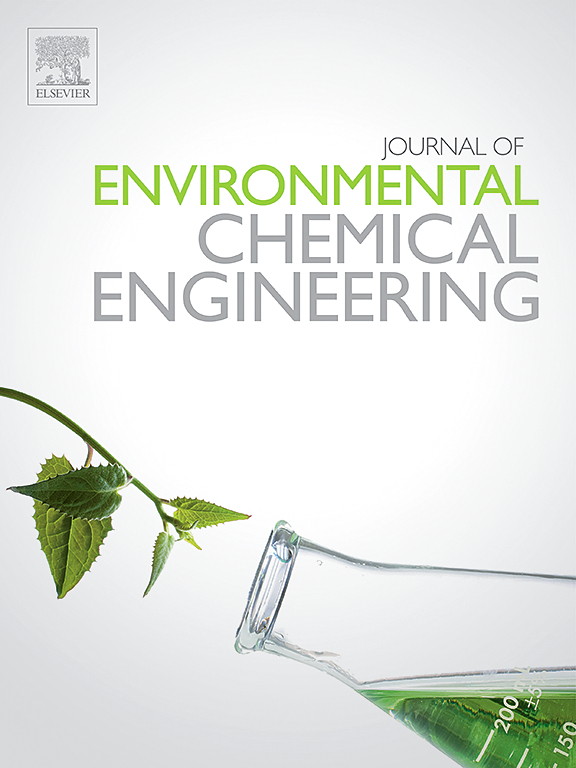In situ preparation of imidazolyl ionic liquid molecular cation moisture-resistant A3Bi2I9 perovskite crystals for efficient photocatalytic water purification and hydrogen production
IF 7.4
2区 工程技术
Q1 ENGINEERING, CHEMICAL
引用次数: 0
Abstract
Bismuth-based halide perovskites are semiconductors that respond well to light and can be used in reactions triggered by visible light. However, their structure makes them unstable in wet or aqueous conditions, limiting their use in water-based reactions. This paper presents a new method to create two moisture-resistant bismuth-based perovskites, (1,3-diethylbenzimidazole)3Bi2I9 and (1-Methyl-3-ethyl-benzimidazole)2(1,3-diethylbenzimidazole)Bi2I9, by using N-methylbenzimidazole and N-ethylbenzimidazole with bismuth iodide. During this process, ethanol molecules in the solvent modify the N atoms at the 3-position of the benzimidazole molecules, with the help of hydroiodic acid, to form ionic liquids. The new perovskite materials do not contain alkali metal ions or organic ammonium ions, but rather ionic liquid cations (1,3-diethylbenzolamazole)+ and (1-methyl-3-ethylbenzimidazole)+, thus giving them excellent moisturizing properties. The study also improves the photocatalytic performance of these materials by making them into micron-sized sheets using the anti-solvent method. Under visible light, the materials show high efficiency in reducing Cr(VI) (95.3 % and 92.3 % for the two materials) and producing hydrogen from HI splitting (2053.59 and 1957.76 μmol g−1h−1). This research not only develops a method for creating moisture-resistant perovskites with ionic liquids but also shows potential for using these materials in photocatalytic reactions in water.
咪唑基离子液体分子阳离子耐湿A3Bi2I9钙钛矿晶体的原位制备用于高效光催化水净化和制氢
铋基卤化物钙钛矿是对光反应良好的半导体,可用于由可见光引发的反应。然而,它们的结构使它们在潮湿或含水条件下不稳定,限制了它们在水基反应中的应用。本文以n -甲基苯并咪唑和n -乙基苯并咪唑与碘化铋为原料,制备了两种抗湿铋基钙钛矿(1,3-二乙基苯并咪唑)3Bi2I9和(1-甲基-3-乙基苯并咪唑)2(1,3-二乙基苯并咪唑)Bi2I9。在此过程中,溶剂中的乙醇分子在氢碘酸的帮助下,修饰苯并咪唑分子3位的N原子,形成离子液体。新型钙钛矿材料不含碱金属离子或有机铵离子,而是离子液体阳离子(1,3-二乙基苯并咪唑)+和(1-甲基-3-乙基苯并咪唑)+,因此具有优异的保湿性能。该研究还通过使用反溶剂方法将这些材料制成微米尺寸的薄片,从而提高了这些材料的光催化性能。在可见光下,两种材料的Cr(VI)还原效率分别为95.3 %和92.3 %,HI裂解产氢效率分别为2053.59和1957.76 μmol g−1h−1。这项研究不仅开发了一种用离子液体制造耐湿钙钛矿的方法,而且还显示了将这些材料用于水中光催化反应的潜力。
本文章由计算机程序翻译,如有差异,请以英文原文为准。
求助全文
约1分钟内获得全文
求助全文
来源期刊

Journal of Environmental Chemical Engineering
Environmental Science-Pollution
CiteScore
11.40
自引率
6.50%
发文量
2017
审稿时长
27 days
期刊介绍:
The Journal of Environmental Chemical Engineering (JECE) serves as a platform for the dissemination of original and innovative research focusing on the advancement of environmentally-friendly, sustainable technologies. JECE emphasizes the transition towards a carbon-neutral circular economy and a self-sufficient bio-based economy. Topics covered include soil, water, wastewater, and air decontamination; pollution monitoring, prevention, and control; advanced analytics, sensors, impact and risk assessment methodologies in environmental chemical engineering; resource recovery (water, nutrients, materials, energy); industrial ecology; valorization of waste streams; waste management (including e-waste); climate-water-energy-food nexus; novel materials for environmental, chemical, and energy applications; sustainability and environmental safety; water digitalization, water data science, and machine learning; process integration and intensification; recent developments in green chemistry for synthesis, catalysis, and energy; and original research on contaminants of emerging concern, persistent chemicals, and priority substances, including microplastics, nanoplastics, nanomaterials, micropollutants, antimicrobial resistance genes, and emerging pathogens (viruses, bacteria, parasites) of environmental significance.
 求助内容:
求助内容: 应助结果提醒方式:
应助结果提醒方式:


